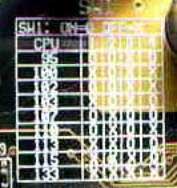Gigabyte GA-7ZMM Socket-A KM133 micro-ATX
by Mike Andrawes on March 11, 2001 2:23 AM EST- Posted in
- Motherboards
Something Missing: Overclocking
The AMD Duron is the processor of choice for a KM133 motherboards - afterall,they’re both designed for the value market.
With price effectiveness in mind, the Duron immediately posts another advantage: cost / overclocking ratio. As shown in our “Best of 2000” poll, Duron is the people’s choice for Best Hardware. Part of the reason everyone loves it is because they can generally get the processors for a relatively low price, and they are able to overclock the CPUs quite a bit, stretching their hardware dollars even further.
In our AMD Socket-A CPUs Overclocking Guide, we discussed that the ability to change the multiplier of Socket-A processors is the secret behind their dramatic overclocking ability. In order to change the multiplier, the motherboard must have certain hardware circuitry.
However, that’s exactly what the GA-7ZMM is missing, which is no surprise since Gigabyte has never released a Socket-A motherboard with multiplier settings. Our sources tell us that they are currently working on a Socket-A motherboard that has multiplier settings, but we have no idea when that will actually surface.
Gigabyte also provides just a handful of FSB speed settings on the GA-7ZMM - 95 / 100 / 102 / 103 / 107 / 110 / 113 / 115 / 133 MHz. Generally FSB speeds higher than 110MHz are not that useful as the chipset cannot maintain much stability at all. Ideally we’d have FSB speeds in 1MHz increments between 100 and 115MHz. The FSB speeds are controlled by a set of DIP switches on the motherboard.


Making matters even worse for overclockers, the GA-7ZMM also lacks CPU core voltage controls. Interestingly enough, this micro-ATX motherboard features a total of three on-board fan connectors. The GA-7ZMM uses the AMI BIOS Easy Setup 1.24a. You can monitor the speed of two of the three fans as well as two temperatures from within the BIOS.
In terms of stability, the GA-7ZMM is merely average. Gigabyte put in a total of fifteen 1200uF capacitors around the CPU socket, the VIA 8365 North Bridge, and the DIMM slots. These Low Equivalent Series Resistance (ESR) capacitors helps to ensure the signals are clean at high frequency, and they also help to ensure that there is enough power supplied to the CPU socket.










0 Comments
View All Comments